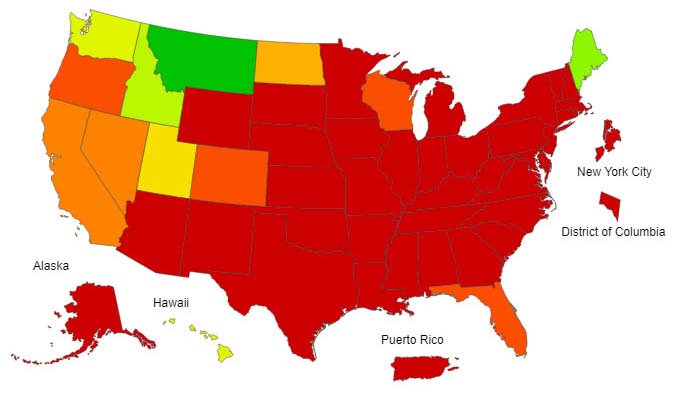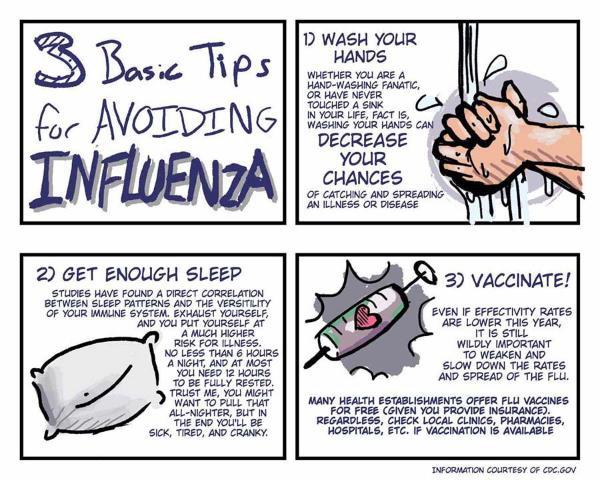Record Flu Season Felt on Cape
by Joe Thorpe
The 2017-18 flu season is shaping up to be one of the worst the U.S. has seen since the Center for Disease Control and Prevention (CDC) redefined its data collection protocols in 2003. Before that time many statistics were not gathered or were not reported. The number of deaths attributed to influenza and pneumonia last week is at 10.1%, that means 1 out of 10 deaths were determined a direct consequence of an influenza virus, approximately 4,000 people died.

Image: 2017–2018 Influenza Season Week 6 ending February 10, 2018. Dark red indicates greater severity, green indicates minimal impact.
Influenza virus A (H3N2) has been the most frequently identified virus subtype by public health laboratories this season. This strain is often connected to severe illness, and especially dangerous to the at-risk groups of children younger than five, persons 65 or older, pregnant women, American Indian and Alaska Natives, and people with medical conditions.
So far there have been 63 confirmed pediatric deaths caused by the flu. Parents should seek prompt medical care for young children and at-risk children with flu symptoms.
Hospitalizations are higher than what has been recorded since the CDC’s current surveillance system began. Influenza-like illness (ILI) has increased last week to 7.7%, crossing the parallel of the 7.6% of the swine flu pandemic of 2009, and is above the national baseline of 2.2%. Test results from public health laboratories have reported 27,667 cases as positive for any strain of the influenza virus since October 1st, 2017.
The geographic spread of influenza was reported as widespread for the first time in the continental U.S. In New England all states are reporting regional and widespread activity across each region, and 26.3% of respiratory specimens tested positive for flu in clinical laboratories. The Massachusetts Department of Public Health reports 8,152 laboratory-confirmed cases as of February 9th, 2018. The U.S. is now entering a second wave of influenza in proportion of B type influenza virus strain, and A (H1N1), which is not uncommon.
The CDC says hospitalizations of younger groups and higher levels of ILI are where the records this season will be. It is difficult to estimate the number of deaths as they tend to come after lengthy hospitalizations. One bright spot is the A (H3N2) virus numbers are shrinking, thought to be the more severe strain.
“[The] flu is relatively difficult to predict, and we don’t know we’ve hit the peak yet,” said CDC Acting Director Anne Schuchat. “In the past five seasons, influenza-like illness has been elevated for between eleven and twenty weeks, and we’re only at week eleven now, so we could potentially see several more weeks of activity. [The] flu is incredibly complex and difficult to predict, and this season is a somber reminder of why flu is one of the world’s greatest public health challenges.”
David “Sonny” Chilcutt, a non-traditional Childhood Education major and peer tutor attending Cape Cod Community College (4Cs) part-time since 2016 contracted the flu just before the end of the fall semester 2017. His symptoms began with a continuous cough that lasted through the night. Soon came muscle cramps, dizziness, and cold sweats. Never developing a fever, Chilcutt presumed he had a bad cold and went about his business. By the next day, he had such great trouble breathing he was rushed to Falmouth Hospital by ambulance.
Despite having a clean bill of health and a strong immune system, Chilcutt developed a respiratory infection and massive amounts of fluid around his heart and lungs. After four days in the hospital, he was sent home with the warning he would likely remain ill for several weeks.
Chilcutt missed his final exams. Being sick, and with the winter holidays over break between semesters, Chilcutt had to wait until two weeks into the current spring semester to make-up his finals
“I was caught not being able to take exams, which turned out to be a temporary nightmare,” said Chilcutt. “I can’t thank [the professors and advisers] enough in assisting me with coordinating my spring schedule and my make-up exams. Their overall communication was commendable and helped me get back onboard school as soon as possible.”
The flu is an infectious disease caused by the influenza virus. Symptoms of the flu can range from mild to severe. The most common symptoms are; high fever, runny nose, sore throat, muscle pain, headache, coughing, pain or pressure in the chest or abdomen, confusion, and feeling tired.
In children, symptoms may include nausea and vomiting, fast or difficulty breathing, bluish skin color, not drinking enough fluids, not waking-up or interacting, being too irritable to be held, and fever with a rash. Seek medical attention immediately for children who are unable to eat, have no tears when crying, or have significantly fewer wet diapers.
A serious flu symptom is if you get sick, begin to recover, and then become worse. This may be an infection of a secondary bacterial pneumonia, and you should seek medical attention immediately. Symptom typically begin within two days after exposure and usually last less than a week, but the cough may persist longer.
There is no definitive answer why flu season occurs. Proposed reasons are; people are more often indoors together promoting opportunity for transmission, a seasonal decline in ultraviolet radiation that may otherwise kill or damage the viruses, colder temperatures and drier air that dehydrate a person’s mucus membranes preventing the body from defending against respiratory infections, viruses are possibly preserved in colder temps leading to slower decomposition and lingering on surfaces, or Vitamin D production from ultraviolet-B in the skin changes with the season and affects the immune system.
According to the CDC, the flu vaccine is the first and best way to protect yourself and family. It can reduce flu illnesses, doctor’s visits, missed work or school, prevent hospitalizations, and significantly reduce a child’s risk of dying from influenza.

Illustration: by Daeg Hamilton
Since every flu season is an epidemic, no person is safe from infection. It is recommended by the CDC that every person age six months or older receive a flu shot every year.
There has been much rumor as to the this season’s vaccine effectiveness worldwide fighting this season’s widely spread A (H3N2) strain. There are no conclusive results yet in the U.S., but in Australia, where flu season has just finished, the same vaccine is estimated to have prevented illness only 10% of the time. The preliminary estimate for the U.S. is as high as 30%.
Flu shots are easy to come by, and are either inexpensive or free. A person can be vaccinated by a doctor, a local pharmacy, and students at 4Cs can take advantage of annual flu clinics put on by the Barnstable County Public Health Department. Last week a second flu clinic was added due to the severity of this year’s outbreak by 4Cs Vice-President Susan Miller.
If you do contract a flu virus, “[Students should] follow the general guidelines which are; eat well, sleep well, wash hands, cover your mouth if you have a cough, and if you are sick don’t come to school,” said Miller. “I know it’s a hard thing to do, but communicate with a faculty member, and do your fellow students and your colleagues a favor by staying home and taking care of yourself.”
Categories: Featured, Student Life